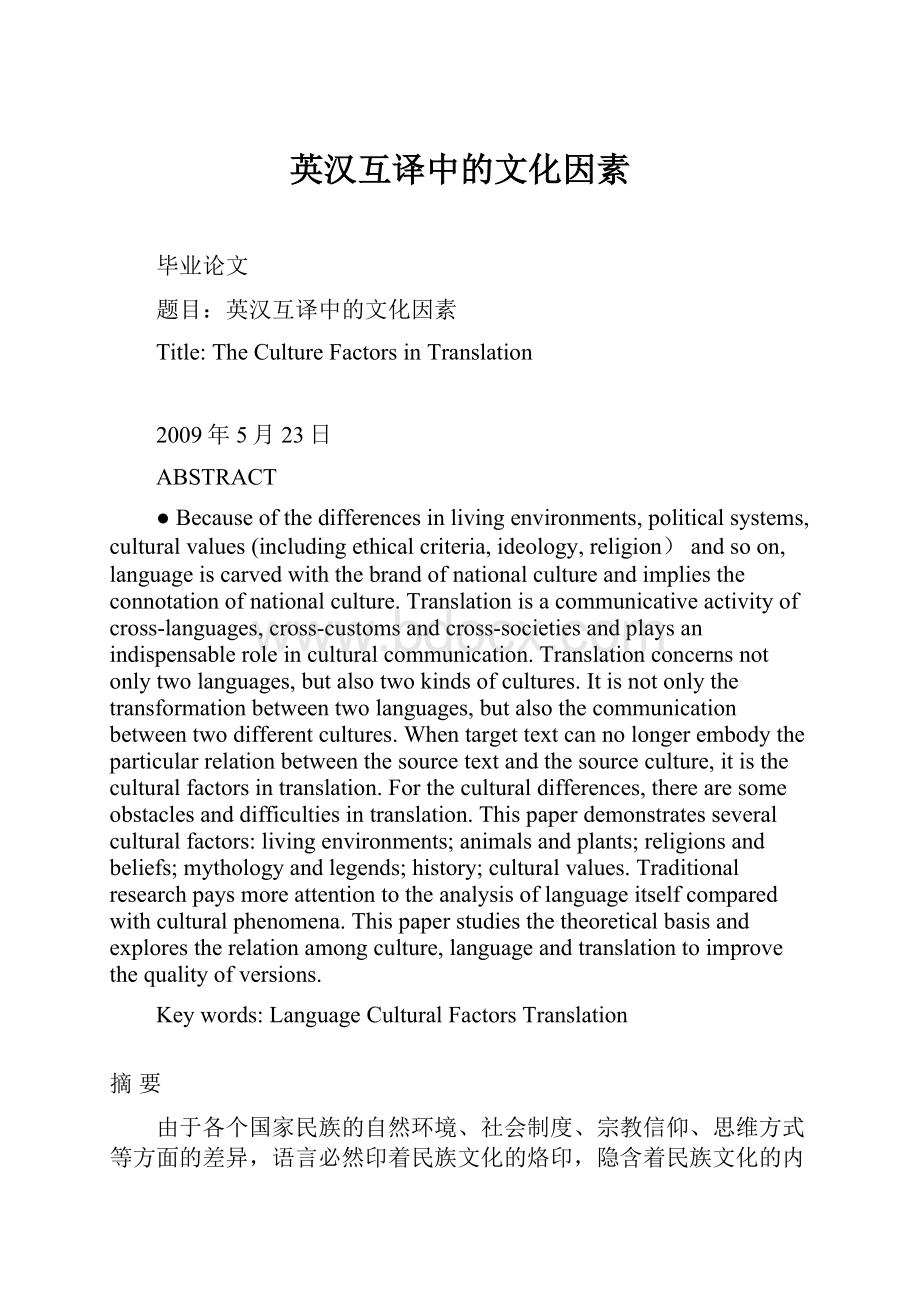英汉互译中的文化因素Word文档格式.docx
《英汉互译中的文化因素Word文档格式.docx》由会员分享,可在线阅读,更多相关《英汉互译中的文化因素Word文档格式.docx(22页珍藏版)》请在冰豆网上搜索。

livingenvironments;
animalsandplants;
religionsandbeliefs;
mythologyandlegends;
history;
culturalvalues.Traditionalresearchpaysmoreattentiontotheanalysisoflanguageitselfcomparedwithculturalphenomena.Thispaperstudiesthetheoreticalbasisandexplorestherelationamongculture,languageandtranslationtoimprovethequalityofversions.
Keywords:
LanguageCulturalFactorsTranslation
摘要
由于各个国家民族的自然环境、社会制度、宗教信仰、思维方式等方面的差异,语言必然印着民族文化的烙印,隐含着民族文化的内涵。
翻译作为跨文化交流的桥梁,在沟通交流、丰富人类文化中起着不可或缺的作用。
翻译的根本任务就是传播和交流文化。
因此,翻译既涉及两种语言,更涉及两种文化。
翻译不仅是两种语言的转换活动,更是两种文化的交流。
在翻译过程中,不同文化在各自语言中的积淀会明显表现出来,相对独立,使译文无法再现原文与源文化的那种特定关系,这便是翻译中的文化因素。
文化差异的存在使语言的翻译存在诸多障碍和困难。
本文从文化的几个因素分别阐述和论证了文化对语言和翻译的影响:
地理环境和气候;
动植物;
宗教信仰;
神话传说;
历史;
颜色;
心理文化和价值观念差异。
关键词:
语言;
文化因素;
翻译
CONTENTS
Introduction1
Ⅰ.Therelationshipamongculture,language,andtranslation2
1.1Whatisculture?
2
1.2WhatisLanguage?
3
1.3LanguageandCulture4
1.4Language,cultureandtranslation5
ⅡTheimpactofculturalfactorsontranslation7
2.1Environment7
2.2Religions8
2.3Animalsandplants9
2.4Customs10
2.5History13
2.6Color14
2.7DifferentPsychologicalCulturesandValueSystems15
ⅢMethodsofTranslation17
3.1literaltranslation17
3.2freetranslation17
3.3Addinginformationsupplementstotranslation18
BIBLIOGRAPHY20
Introduction
Languageisnotingdownthehistoryofculturesofhumanbeings.Butcultureischaracterizedbydistinctnationalityandiscreatedbydifferentnationsinparticularenvironmentofhistory,geography,religion,customandsoon.Translationistopresentinanotherculturethemeaningandimplicationthatthetexthasinaspecificculturalcontext.Innature,translationisakindofcommunicationbetweencultures.Duringtheprocessoftranslation,theinterpretationandexpressionoftheconnotationofcultureemergeasproblemstobesolvedatthefirstplace.Thatrequiresthetranslatorsnotonlyshouldhavebilingualabilitiesbutalsoshouldhavetheknowledgeoftwoculturesof,evenseveralcultures.Theessenceoftranslationisthecommunicationbetweentwodifferentcultures.“Fortrulysuccessfultranslation,biculturalismisevenmoreimportantthanbilingualism”citingafamouslinguistNida,1993.
E.B.Tylor,ananthropologist,thoughtcultureisacomplicatedgathering,includingknowledge,belief,arts,moralstandards,law,customsandalltheabilitiesandhabitsofindividualsasmembersofasociety.Thescopeofcultureisextremelywide-ranging.Languageisthereflectionofculture.Anykindoflanguagebasesonthegroundofcertainculture.Sotounderstandthesourcelanguageandtheoriginaltext,translatorshavetoanalyzethoseculturalcharacteristics.
Thispaperstudiesthetheoreticalbasisofthetranslationofculturebyexploringtherelationshipamongculture,languageandtranslationtoimprovethequalityofversions.Becauseoftheculturaldifferences,therearesomeobstaclesanddifficultiesintranslation.Theimpactsofcultureontranslationaredemonstratedinthispaperfromseveralaspects:
culturalvalues.
Ⅰ.Therelationshipamongculture,language,andtranslation
Accordingtothetraditiontheoryoftranslation,peopleconsideredtranslatingactivitiesasaprocessoftransferbetweentwolanguages.Inthe1970s,thestudytendedtodevelopinseveraldirectionsinthatitwasnolongerrestrictedtothetraditionaestheticandlinguisticstudyandbecomeculturalrethinking.
1.1Whatisculture?
Infact,cultureisalargeandabstractconceptsothatitisverycomplexanddifficulttodefine.Itissaidthattherehavebeenatleastover150definitionsofculture.Thenwewilltakesomeforexample.
“Cultureisman’smedium;
thereisnotoneaspectofhumanlifethatisnottouchedandalteredbyculture.Thismeanspersonality,howpeopleexpressthemselves,includingshowsofemotion,thewaytheythink,howtheymove,howproblemsaresolved,howtheircitiesareplannedandlaidout,howtransportationsystemsfunctionandareorganized,aswellashoweconomicandgovernmentsystemsareputtogetherandfunction.”(Hall,1959)“By‘culture’,anthropologymeansthetotallifewayofapeople,thesociallegacytheindividualacquiresfromhisgroup.Orculturecanberegardedasthatpartoftheenvironmentthatisthecreationofman.”(Kluckhohn,1965)
“Acultureisacollectionofcollectionofbeliefs,habits,livingpatterns,andbehaviorswhichareheldmoreorlessincommonbypeoplewhooccupyparticulargeographicareas.”(Brown,1978)
Cultureemergesindistinctivewayswithindifferentplaces.Suchas,inwestern,peopleliketodrinkcoffeewhileChineseprefertotea.Moreover,cultureisacomplicatedsystemincludingandinfluencingalmostalltheaspectsoflifeinasocietylikeknowledge,belief,arts,moralstandards,law,customsandalltheabilitiesandhabitsofindividuals:
hereknowledgereferstoacademicsubjects,bothscientificandnotscientific,forexample,mathematicsandlinguistics;
beliefcouldbedividedintotwosorts,politicalandreligious,whicharedifferentamongpeoplesandoftencoursedifferentcomprehensionandevenconflicts,examplesareChristianityinthewestcountriesandIslamintheMuslincountries;
artscomprisepainting,architecture,sculpture,literature,opera,dancing,musicetc;
ethicsisasetofprinciplesthatpeopleusetodecidewhatisrightandwhatiswrong.Surelythelanguagethatthesocietyusesisapartofculturewithnoexception.Mostofcultureisimplantedbythesurroundingwelive,ourmethodandbehavioraredeep–rootedinheart.Therefore,ascompetenttranslators,wemustletourselvesbeintothetwoorevenmorecultures.
1.2WhatisLanguage?
Language,asystemofsounds,words,patterns,ect,usedbyhumantocommunicatethoughtsandfeelings,isnotingdownthehistoryofculturesofhumanbeings.Webeginourpreviewoflanguagebynotingthatisimpossibletoseparateouruseoflanguagefromourculture.Withthemostbasicsense,languageisasetofsymbolsandtherulesforcombiningthosesymbolsthatareusedandunderstoodbyalargecommunityofpeople.Whenwestudyanotherlanguage,wesoondiscoverthatnotonlyarethesymbols(words)andsoundsforthosesymbolsdifferent,butalsoaretherules(phonology,grammar,syntaxandintonation)forusingthosesymbolsandsounds.
Worddifferencesareobviousinvariouslanguages.InEnglish,weliveinahouse.InSpanish,weliveinacasa.InTai,weliveinaban.Phonologyalsovariesculturally.InEnglish,wehave21consonantsand5vowelsandcombinetoform38variousphonemes.Vietnamesehas34segmentalphonemesconsistingofvowels,semi-vowelsandconsonants.TheFilipinolanguagehas21consonantsand13vowelsthatform26phonemes.Grammaticalstructuresareuniquetoeachlanguageaswell.InEnglish,wehavesingularandpluralnounsandpronouns,butinKorean,thedistinctionbetweensingularandpluralismadebythecontextofthesentence.InEnglish,verbtensesexpresscontrastbetweenpast,present,andfutureacts,butinVietnamese,thesameverbreflectsallthreeandthetimeoftheactionisinferredfromthecontext.Syntax,orthewordorderandstructureinthesentence,alsovariesdependingonthelanguage.ThenormalwordorderforsimplesentencesinVietnameseisthereverseofthewordorderinEnglish.Forexample,theEnglishsentence"
Theteacherdied"
wouldbe"
Namatayangguro"
or"
Diedtheteacher"
inFilipino.InEnglishthesubjectisfollowedbyaverbandthenanobject,butinJapanese,thesubjectisfollowedbytheobjectandthentheverb.SoinEnglishwemightsay,"
Johnsawthedog."
butinJapanese,"
Johnthedogsaw"
wouldbecorrect.
Theseexamplesindicatethatifwewanttocommunicateinanotherlanguage,itisimportantforustoknownotonlythesymbols(words)ofthatlanguage,butalsotherulesforusingthosesymbols.Asweknow,languageismuchmorethansymbolandrulesystemthatallowsustocommunicatewithotherperson.ThelinguistNidasaidthat‘alanguageisalwaysapartofaculture,andthemeaningofanytextrefersdirectlyorindirectlytothecorrespondingculture’.Alllanguagesgrowonthegroundofcertaincultures.Thuslanguagesbeartheircharacteristicsinaccordancewiththoseofspecificcultures.
1.3LanguageandCulture
Languageandcultureinfluenceeachother,reflecteachotherandco-existwitheachother.Differentculturesresultindifferentlanguage.Differentlanguagesinturncausedifferentcommunicativepatternsandfinallydifferencesbetweencultures.LanguageanditsculturalinfluenceareexemplifiedinthetheoreticalformulationsoftheSapir-Whorfhypoth